Embedded HVDC System Planning Methods for Typical Scenarios in Regional Power Grids
Abstract
1. Introduction
2. Application Scenarios of Embedded HVDC
2.1. Scenario 1: Reinforcement of Transmission Section
2.2. Scenario 2: Delivery of New Energy
2.3. Scenario 3: Interconnection of Power Supply Zones
3. Assessment Indices
3.1. Power Flow Constraint
3.2. Shift Factor Constraint
3.3. Short-Circuit Current Constraint
3.4. Economy Analysis
4. Planning Methods for Different Scenarios
4.1. Planning Method for Reinforcement of Transmission Section
4.1.1. Demand
4.1.2. Capacity
4.1.3. Embedded Points
4.1.4. Multi AC Line Overload
4.2. Planning Method for Delivery of New Energy
4.2.1. Demand
4.2.2. Capacity
4.2.3. Embedded Points
4.3. Planning Methods for Interconnection of Power Supply Zone
4.3.1. Demand
4.3.2. Capacity
4.3.3. Embedded Points
4.3.4. Multi Power Supply Zone
5. Case Study
5.1. Embedded HVDC Scheme for the Cross–Yangtze Transmission Section in Jiangsu
5.1.1. Construction Demand
5.1.2. Capacity Determination
5.1.3. Embedded Point Selection
5.1.4. Discussion
- (1)
- Margin improvement: Similar to the effect of installing a 2000 MW embedded DC, it can relieve the power margin of the original line by about 15%. However, the line capacity is much larger than that of the DC, and the efficiency of load margin improvement using the AC solution is insufficient.
- (2)
- Short-circuit current: For Bus Fengcheng, the short-circuit current increases by 3.5 kA, and the short-circuit current margin is already 0. The short-circuit currents of the remaining 500 kV busbars also increase, and there is a risk of the short-circuit current exceeding the standard when using the AC solution.
5.2. Embedded HVDC Scheme of Offshore Wind Power in Jiangsu
5.2.1. Construction Demand
5.2.2. Capacity Determination
5.2.3. Embedded Point Selection
5.2.4. Discussion
5.3. Embedded HVDC Scheme for Interconnection of Power Supply Zones in Nanjing, Jiangsu
5.3.1. Construction Demand
5.3.2. Capacity Determination
5.3.3. Embedded Point Selection
5.3.4. Discussion
6. Conclusions
- (1)
- In the scenario of transmission section reinforcement, the embedded HVDC scheme is more feasible compared with the AC scheme. It can meet the requirements of power transmission and control, effectively relieve the load of the current lines, and the short-circuit current does not exceed the limit.
- (2)
- In the scenario of offshore new power delivery, the embedded HVDC scheme is more efficient compared with the AC scheme. Both the nearby-landing scheme and the direct-transmission scheme can be adopted. The former scheme is more economical, while the latter scheme can reduce the load on coastal lines.
- (3)
- In the scenario of power supply zone interconnection, the embedded HVDC scheme enables the direct power exchange capability for low-voltage-level power supply and improves the load margin of the main transformers, which cannot be achieved with the AC scheme.
Author Contributions
Funding
Data Availability Statement
Conflicts of Interest
References
- Zhang, Z.; Kang, C. Challenges and Prospects of Building a New Power System under the Carbon Neutrality Goal. Proc. CSEE 2022, 42, 2806–2819. [Google Scholar] [CrossRef]
- Chen, X.; MCELROY, M.B.; Wu, Q.; Shu, Y.; Xue, Y. Transition towards Higher Penetration of Renewables: An Overview of Interlinked Technical, Environmental and Socio-Economic Challenges. J. Mod. Power Syst. Clean Energy 2019, 7, 1–8. [Google Scholar] [CrossRef]
- Wang, M.; An, T.; Ergun, H.; Lan, Y.; Andersen, B.; Szechtman, M.; Leterme, W.; Beerten, J.; Van Hertem, D. Review and Outlook of HVDC Grids as Backbone of Transmission System. CSEE J. Power Energy Syst. 2021, 7, 797–810. [Google Scholar] [CrossRef]
- Wang, W.; Li, G.; Guo, J. Large-Scale Renewable Energy Transmission by HVDC: Challenges and Proposals. Engineering 2022, 19, 252–267. [Google Scholar] [CrossRef]
- Xiao, H.; Gan, H.; Yang, P.; Li, L.; Li, D.; Hao, Q.; Huang, Y.; Dai, L.; Liu, Y. Robust Submodule Fault Management in Modular Multilevel Converters with Nearest Level Modulation for Uninterrupted Power Transmission. IEEE Trans. Power Deliv. 2024, 39, 931–946. [Google Scholar] [CrossRef]
- Huang, Y.; Zhang, J.; Wang, G.; Xu, Z. Transient Stability Analysis and Improvement of Isolated Renewable Energy Bases with VSC-DC Transmission. CSEE J. Power Energy Syst. 2025, in press. [CrossRef]
- CIGRE Joint Working Group C4/B4/C1-604. Influence of Embedded HVDC Transmission on System Security and AC Network Performance; CIGRE Brochure: Paris, France, 2013; p. 5. [Google Scholar]
- Wang, Z.; Huang, J.; Cheng, L.; Hu, W.; Cai, H.; Han, X. Planning and Application of “Embedded” DC Technology in Provincial Power Transmission Networks. Electr. Power Eng. Technol. 2022, 41, 65–74. [Google Scholar]
- Moradi-Sepahvand, M.; Amraee, T. Hybrid AC/DC Transmission Expansion Planning Considering HVAC to HVDC Con-version Under Renewable Penetration. IEEE Trans. Power Syst. 2021, 36, 579–591. [Google Scholar] [CrossRef]
- Lotfjou, A.; Fu, Y.; Shahidehpour, M. Hybrid AC/DC Transmission Expansion Planning. IEEE Trans. Power Deliv. 2012, 27, 1620–1628. [Google Scholar] [CrossRef]
- Akbari, E.; Naghibi, A.F.; Veisi, M.; Pirouzi, S.; Safaee, S. High Voltage Direct Current System-Based Generation and Transmission Expansion Planning Considering Reactive Power Management of AC and DC Stations. Sci. Rep. 2025, 15, 15537. [Google Scholar] [CrossRef] [PubMed]
- Franken, M.; Barrios, H.; Schrief, A.B.; Puffer, R. Identification of Suitable Locations for HVDC Links within Meshed AC Networks. In Proceedings of the 2019 IEEE PES Innovative Smart Grid Technologies Europe (ISGT-Europe), Bucharest, Romania, 29 September–2 October 2019; pp. 1–5. [Google Scholar]
- Li, Y.; Qiao, X.; Chen, C.; Tan, Y.; Tian, W.; Xia, Q.; Cao, Y.; Lee, K.Y. Integrated Optimal Siting and Sizing for VSC-HVDC-Link-Based Offshore Wind Farms and Shunt Capacitors. J. Mod. Power Syst. Clean Energy 2021, 9, 274–284. [Google Scholar] [CrossRef]
- He, Y.; Zhong, H.; Ruan, G.; Zhou, B.; Fu, C.; Zhuo, Y. Frequency-Constrained Coordinated Planning of HVDC and Generation. In Proceedings of the 2024 IEEE PES Innovative Smart Grid Technologies Europe (ISGT EUROPE), Dubrovnik, Croatia, 14–17 October 2024; pp. 1–5. [Google Scholar]
- Li, Z.; Jin, B.; Zou, Y. HVDC Terminal Locations Optimization Considering Grid Support Capacity Constraints. In Proceedings of the 2024 IEEE 6th International Conference on Power, Intelligent Computing and Systems (ICPICS), Shenyang, China, 26–28 July 2024; pp. 1620–1625. [Google Scholar]
- Xie, H.; Bie, Z.; Li, G. Reliability-Oriented Networking Planning for Meshed VSC-HVDC Grids. IEEE Trans. Power Syst. 2019, 34, 1342–1351. [Google Scholar] [CrossRef]
- Zhang, L.; Ye, H.; Zhai, Q.; Wei, N.; Liu, S.; Chen, W. Multi-Stage Optimization of Inter-Regional Flexibility with HVDC Tie-Line. In Proceedings of the 2023 5th Asia Energy and Electrical Engineering Symposium (AEEES), Chengdu, China, 23–26 March 2023; pp. 904–909. [Google Scholar]
- Wang, R.; Tang, Q.; Lu, Y.; Gou, J.; Liu, F.; Wen, Y. Robust Transmission Expansion Planning of Hybrid Ultra-HVAC and Ultra-HVDC Grid. In Proceedings of the 2021 IEEE/IAS Industrial and Commercial Power System Asia (I&CPS Asia), Chengdu, China, 18–21 July 2021; pp. 747–751. [Google Scholar]
- Wen, Y.; Lu, Y.; Gou, J.; Liu, F.; Tang, Q.; Wang, R. Robust Transmission Expansion Planning of Ultrahigh-Voltage AC–DC Hybrid Grids. IEEE Trans. Ind. Appl. 2022, 58, 3294–3302. [Google Scholar] [CrossRef]
- Emdadi, K.; Pirouzi, S. Benders Decomposition-Based Power Network Expansion Planning According to Eco-Sizing of High-Voltage Direct-Current System, Power Transmission Cables and Renewable/Non-Renewable Generation Units. IET Renew. Power Gener. 2025, 19, e70025. [Google Scholar] [CrossRef]
- Zhou, Y.; Rehtanz, C.; Dalhues, S.; Luo, P.; Liu, J.; Li, Y.; Chen, H. A Strategy for Access Points Selection and Capacity Configuration for the VSC-HVDC System Considering Overload Scenarios Alleviation. Int. J. Electr. Power Energy Syst. 2021, 124, 106329. [Google Scholar] [CrossRef]
- Li, X.; Zhou, Y.; Zhang, D.; Li, Y.; Li, Y. Location Selection of VSC-HVDC Line Access Points and Capacity Optimization Configuration Method. Electr. Power Autom. Equip. 2020, 40, 113–118, 119–120, 126. [Google Scholar] [CrossRef]
- You, G.; Xiao, L.; Li, L.; Zhu, X.; Yang, J.; Wu, X.; Wang, G.; Xu, Z. Scheme Design Method for Strengthening Power Grids in Typical High-Proportion New Energy Areas Using Flexible DC Technology. Power Capac. React. Power Compens. 2020, 41, 142–150+157. [Google Scholar] [CrossRef]
- Xu, W.; Wang, R.; Zhen, Y.; Li, T.; Wang, Y.; Wen, Y. Adaptability Evaluation of Multi-Send HVDC Power Grid Planning Schemes. In Proceedings of the 2021 4th International Conference on Energy, Electrical and Power Engineering (CEEPE), Chongqing, China, 23–25 April 2021; pp. 235–239. [Google Scholar]
- Guo, X.; Guo, J.; Ma, S.; Wang, C.; Zhang, Y. Multi-DC Landing Point Selection Method Based on Multi-Infeed Short Circuit Ratio. Proc. CSEE 2013, 33, 36–42+21. [Google Scholar] [CrossRef]
- Zhou, Q.; Liu, Y.; Tang, Y. Multi-DC Infeed Landing Point Selection Method Considering DC Weight. Power Syst. Technol. 2013, 37, 3336–3341. [Google Scholar] [CrossRef]
- Xiao, H.; Zhang, Y.; Duan, X.; Li, Y. Evaluating Strength of Hybrid Multi-Infeed HVDC Systems for Planning Studies Using Hybrid Multi-Infeed Interactive Effective Short-Circuit Ratio. IEEE Trans. Power Deliv. 2021, 36, 2129–2144. [Google Scholar] [CrossRef]
- Luo, G.; Shi, D.; Chen, J.; Duan, X. Automatic Identification of Transmission Sections Based on Complex Network Theory. IET Gener. Transm. Distrib. 2014, 8, 1203–1210. [Google Scholar] [CrossRef]

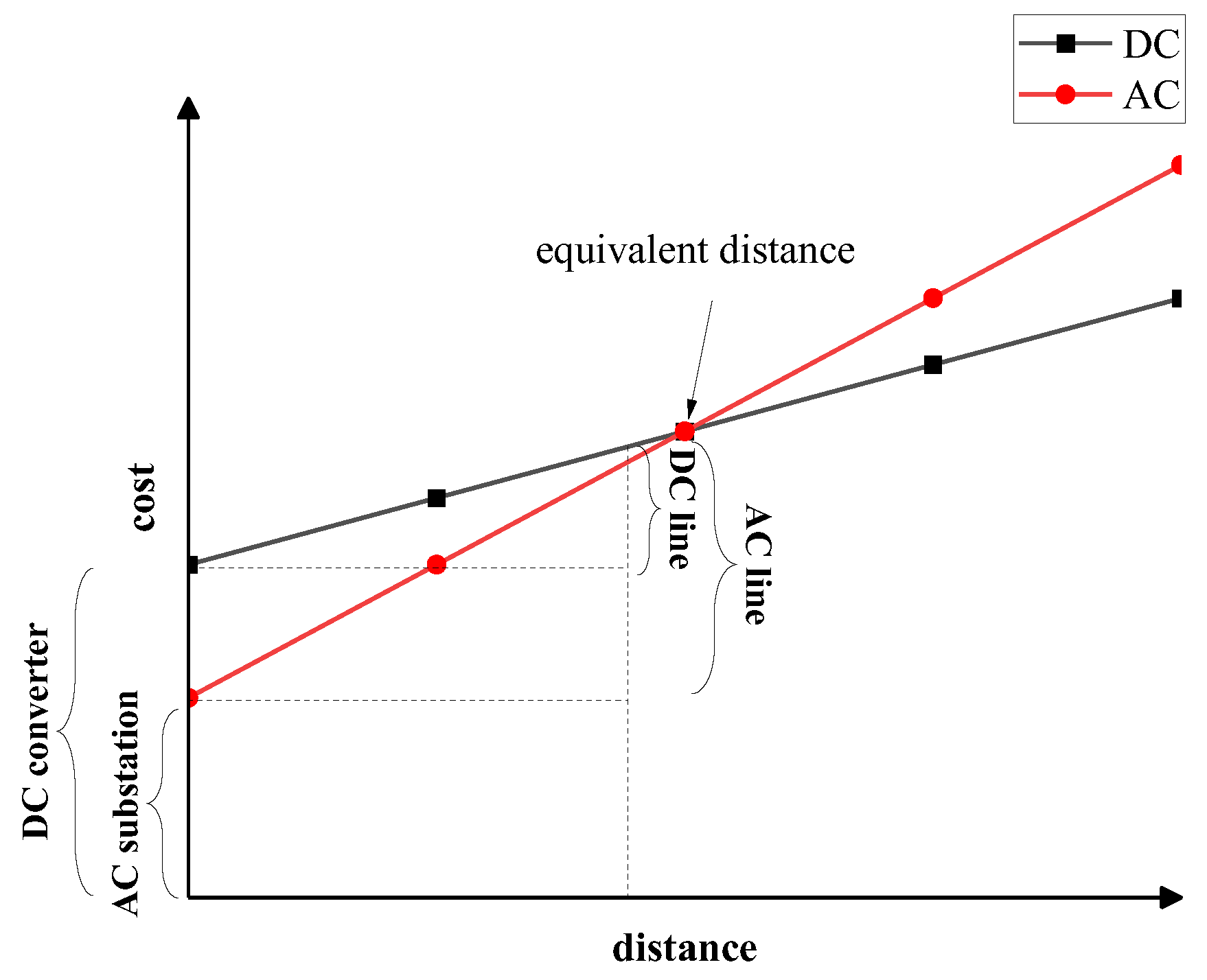
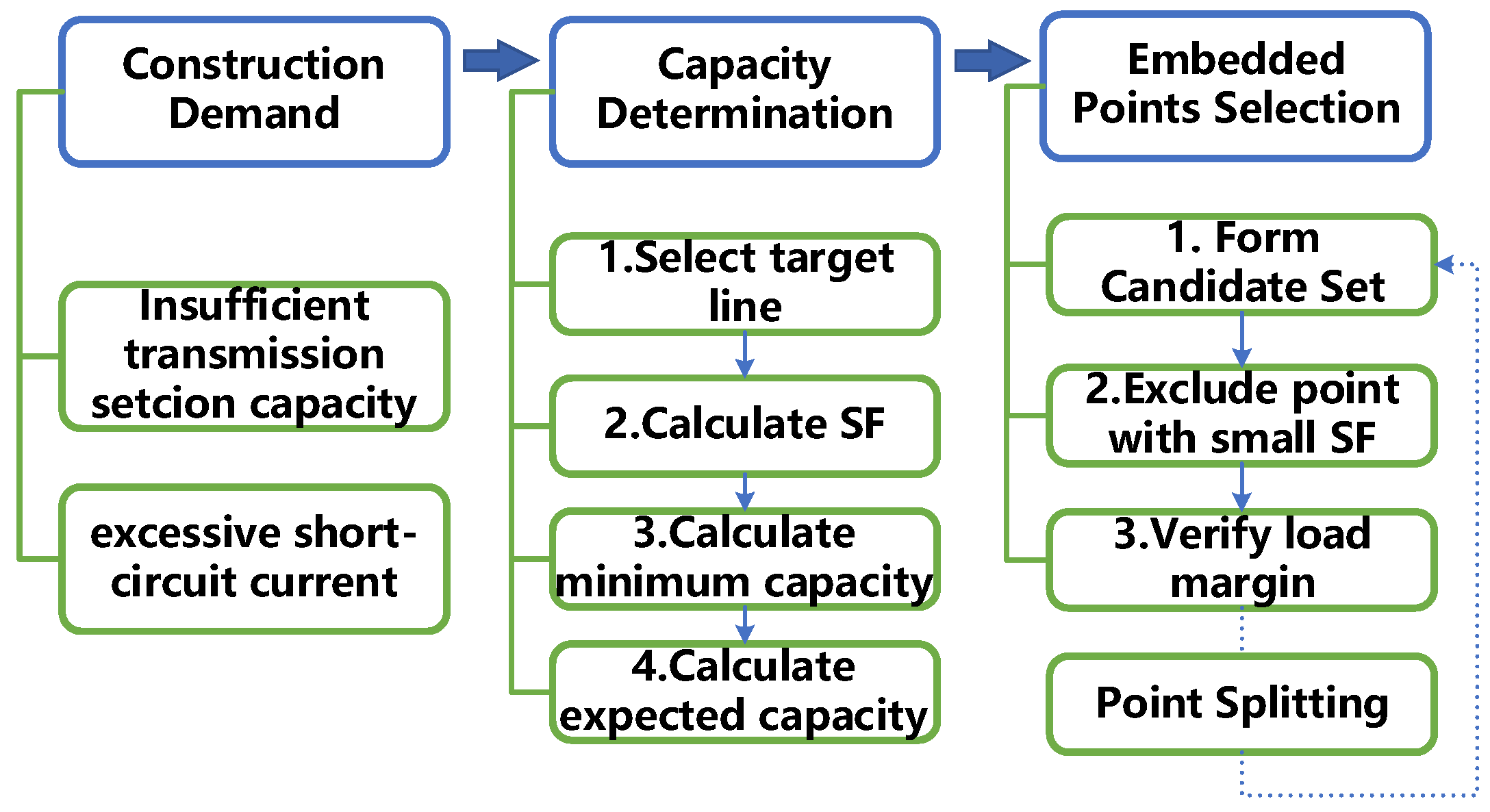
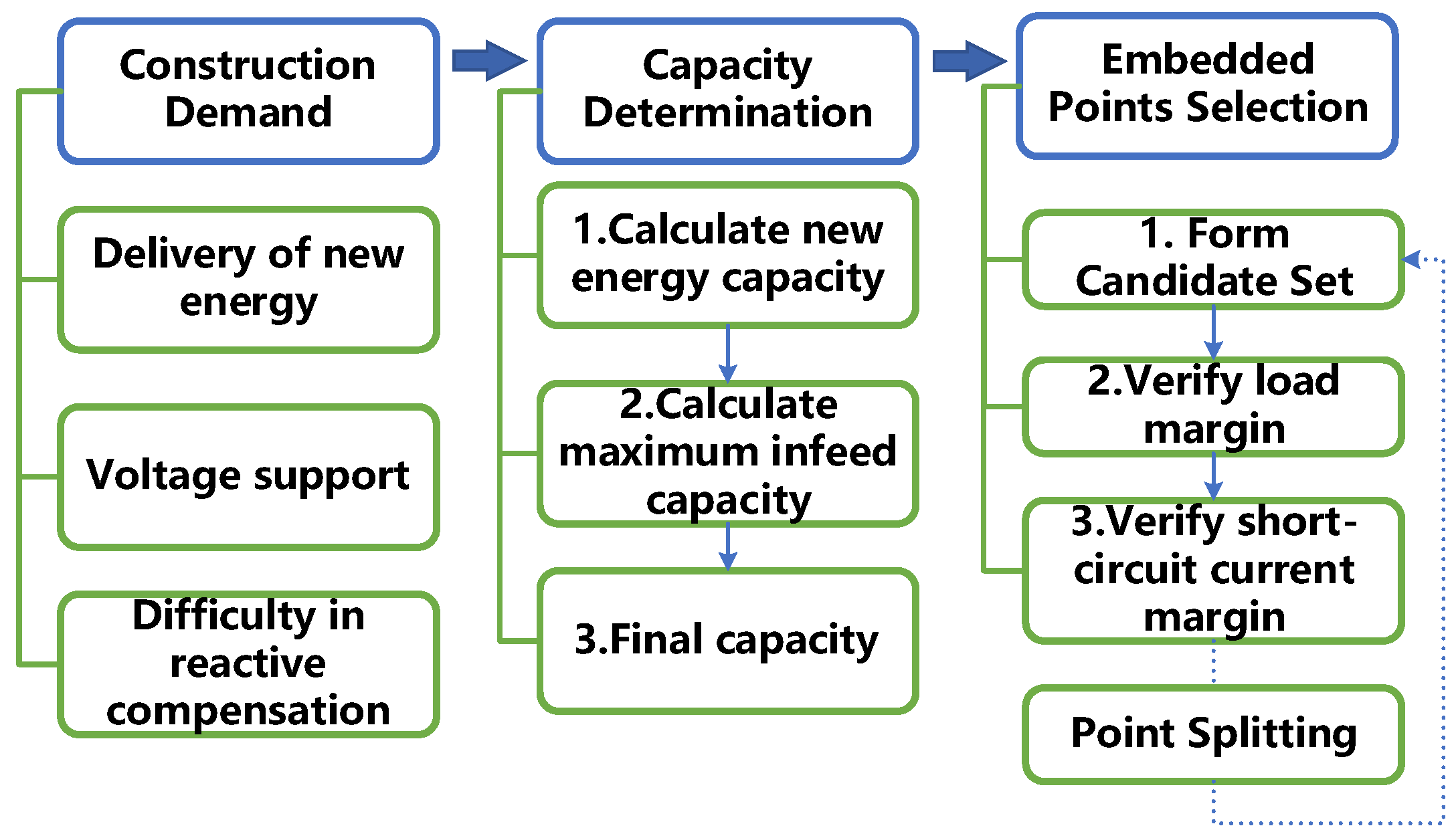

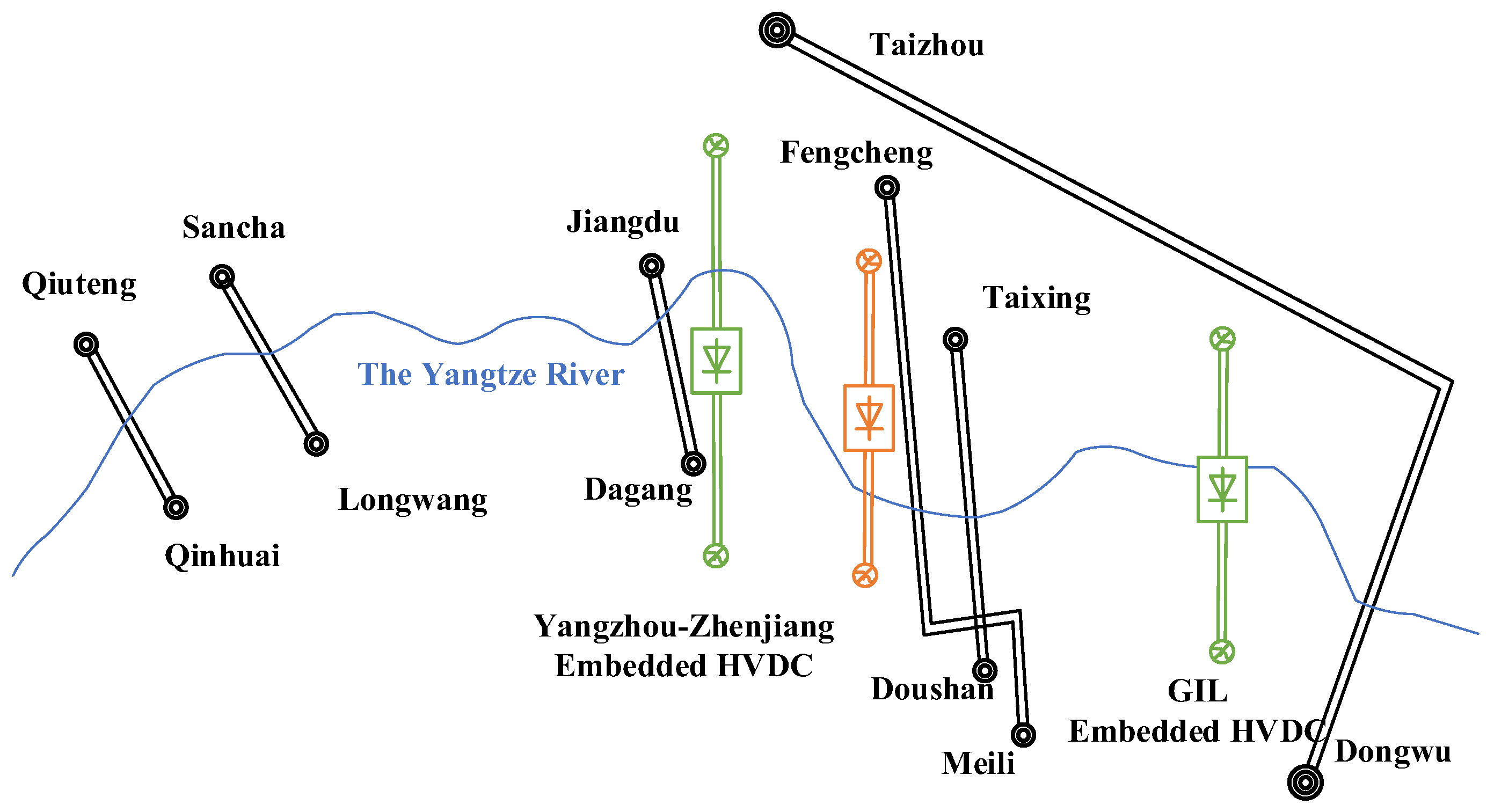


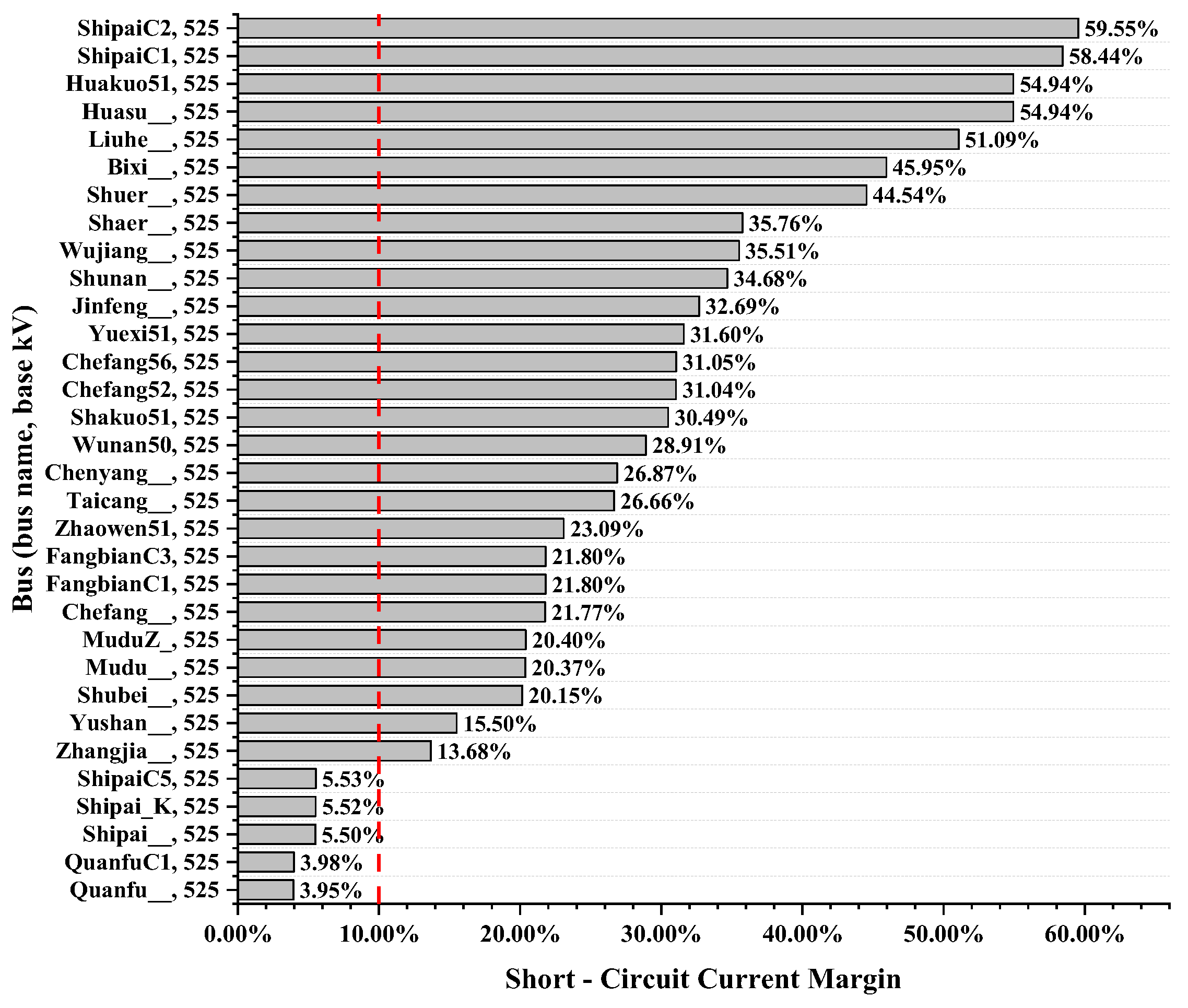

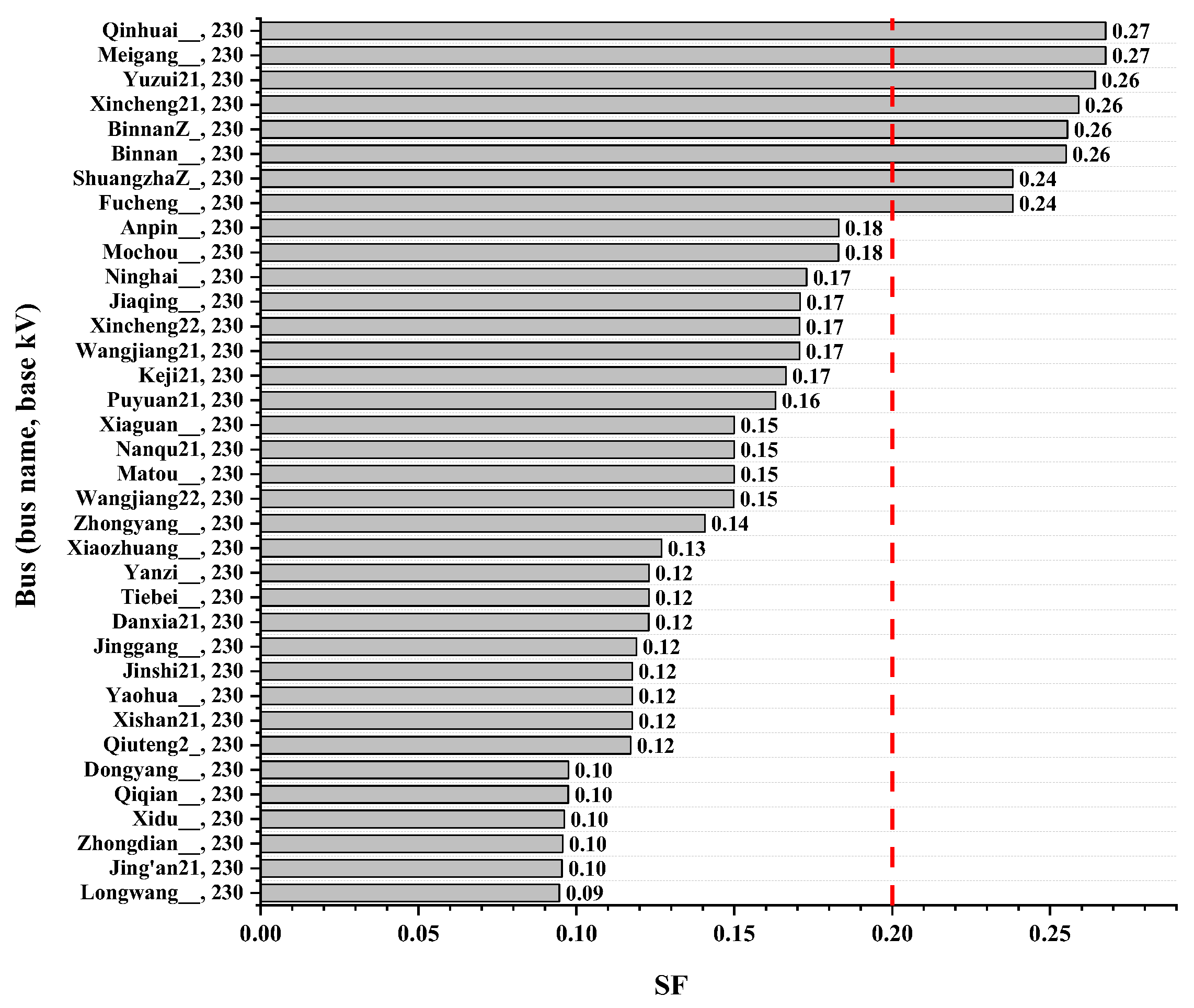
| Bus 1 | Bus 2 | Line ID | Capacity | Active Power | Load Margin |
|---|---|---|---|---|---|
| Qiuteng | Qinhuai | 1 | 4541.3 | 523.6 | 88.5% |
| 2 | 4541.3 | 523.6 | 88.5% | ||
| Sancha | Longwang | 1 | 3496.8 | 1615.5 | 53.8% |
| 2 | 3496.8 | 1649.9 | 52.8% | ||
| Jiangdu | Dagang | 1 | 3633.0 | 1085.4 | 70.1% |
| 2 | 3633.0 | 1035.5 | 71.5% | ||
| Taixing | Doushan | 1 | 2815.6 | 1392.4 | 50.5% |
| 2 | 2815.6 | 1376.8 | 51.1% | ||
| Fengcheng | Meili | 1 | 3500.8 | 2627.1 | 25.0% |
| 2 | 3500.8 | 2635.1 | 24.7% | ||
| Taizhou | Dongwu | 1 | 9081.6 | 3287.7 | 63.8% |
| 2 | 9081.6 | 3287.7 | 63.8% |
| Sending-End Bus (Bus Name, Base kV) | Receiving-End Bus (Bus Name, Base kV) |
|---|---|
| Dasi21, 230 | Jishi21, 230 |
| Fengcheng_K, 230 | Taiwen21,230 |
| Fengcheng__, 230 | Xinan51, 525 |
| Fengcheng__, 525 | Meili__, 230 |
| Meiduo21, 230 | Meili__, 525 |
| Receiving-End Bus (Bus Name, Base kV) | |
|---|---|
| Shu’er__, 525 | Liuhe__, 525 |
| Shunan__, 525 | ShipaiC1, 525 |
| Zhaowen51, 525 | ShipaiC2, 525 |
| Sha’er__, 525 | Huakuo51, 525 |
| Huasu__, 525 | Bixi__, 525 |
| Taicang__, 525 | |
| Sending-End Bus (Bus Name, Base kV) | Receiving-End Bus (Bus Name, Base kV) | |
|---|---|---|
| Tushan21, 230 | Qinglong22, 230 | BinnanZ_, 230 |
| Guanghua__, 230 | Fengcun21, 230 | Fucheng__, 230 |
| Aitao21, 230 | LongwangZ_, 230 | Meigang__, 230 |
| Aitao22, 230 | Songgang21, 230 | Qinhuai__, 230 |
| Dongshan21, 230 | Xianhe__, 230 | Xincheng21, 230 |
| Dongshan22, 230 | Shidai21, 230 | Yuzui21, 230 |
| GaoqiaoF_, 230 | Houxiang__, 230 | |
| Jiaochang21, 230 | Suzhuang__, 230 | |
| Gaoqiao__, 230 | Raocheng21, 230 | |
| Kexue21, 230 | Raocheng22, 230 | |
Disclaimer/Publisher’s Note: The statements, opinions and data contained in all publications are solely those of the individual author(s) and contributor(s) and not of MDPI and/or the editor(s). MDPI and/or the editor(s) disclaim responsibility for any injury to people or property resulting from any ideas, methods, instructions or products referred to in the content. |
© 2025 by the authors. Licensee MDPI, Basel, Switzerland. This article is an open access article distributed under the terms and conditions of the Creative Commons Attribution (CC BY) license (https://creativecommons.org/licenses/by/4.0/).
Share and Cite
Xie, Q.; Huang, Y.; Cai, H.; Wang, G.; Dou, F.; Sun, W. Embedded HVDC System Planning Methods for Typical Scenarios in Regional Power Grids. Electronics 2025, 14, 3292. https://doi.org/10.3390/electronics14163292
Xie Q, Huang Y, Cai H, Wang G, Dou F, Sun W. Embedded HVDC System Planning Methods for Typical Scenarios in Regional Power Grids. Electronics. 2025; 14(16):3292. https://doi.org/10.3390/electronics14163292
Chicago/Turabian StyleXie, Qucheng, Ying Huang, Hui Cai, Guoteng Wang, Fei Dou, and Wentao Sun. 2025. "Embedded HVDC System Planning Methods for Typical Scenarios in Regional Power Grids" Electronics 14, no. 16: 3292. https://doi.org/10.3390/electronics14163292
APA StyleXie, Q., Huang, Y., Cai, H., Wang, G., Dou, F., & Sun, W. (2025). Embedded HVDC System Planning Methods for Typical Scenarios in Regional Power Grids. Electronics, 14(16), 3292. https://doi.org/10.3390/electronics14163292






